Historic Centre of Wismar: Wismar is situated in the northern part of Germany. Wismar was founded around the 12th century. Wismar was a member of the Hanseatic League, during the Late Middle Ages an economic union of trading cities along the coast of Northern Europe. During the 13th and 14th centuries, Wismar was a prosperous Hanseatic town. The natural harbour of Wismar is situated on the Bay of Wismar, one of the bays of the Baltic Sea. The town of Wismar came under the rule of Sweden in 1648, It became part of Germany in 1871, though Sweden officially renounced it claims to the town of Wismar in 1903. The Swedish Rule is still visible in several buildings, such as the Alter Schwede, a brick Gothic patrician house on the Market Square. The Wasserkunst in the Market Square is a wrought iron fountain, imported from the Netherlands in 1602. The half-timbered Gewölbe house served as a quality control station, where wine merchants brought their imported port wines for quality control before trading them. Other memorable monuments in Wismar are the brick Gothic Churches and the Old Town Hall. Wismar was part of the former DDR. Since the German reunification in 1990, the town of Wismar started the restoration of the historic centre and the brick Gothic monuments. Just like Stralsund, Wismar is a good preserved Hanseatic Town on the southern Baltic Coast. The Historic Centre of Wismar is part of the UNESCO World Heritage Site: Historic Centres of Stralsund and Wismar. The Historic Centres of Stralsund and Wismar gained the status as a UNESCO World Heritage in 2002.
www.werelderfgoedfotos.nl © Copyright World Heritage Photos
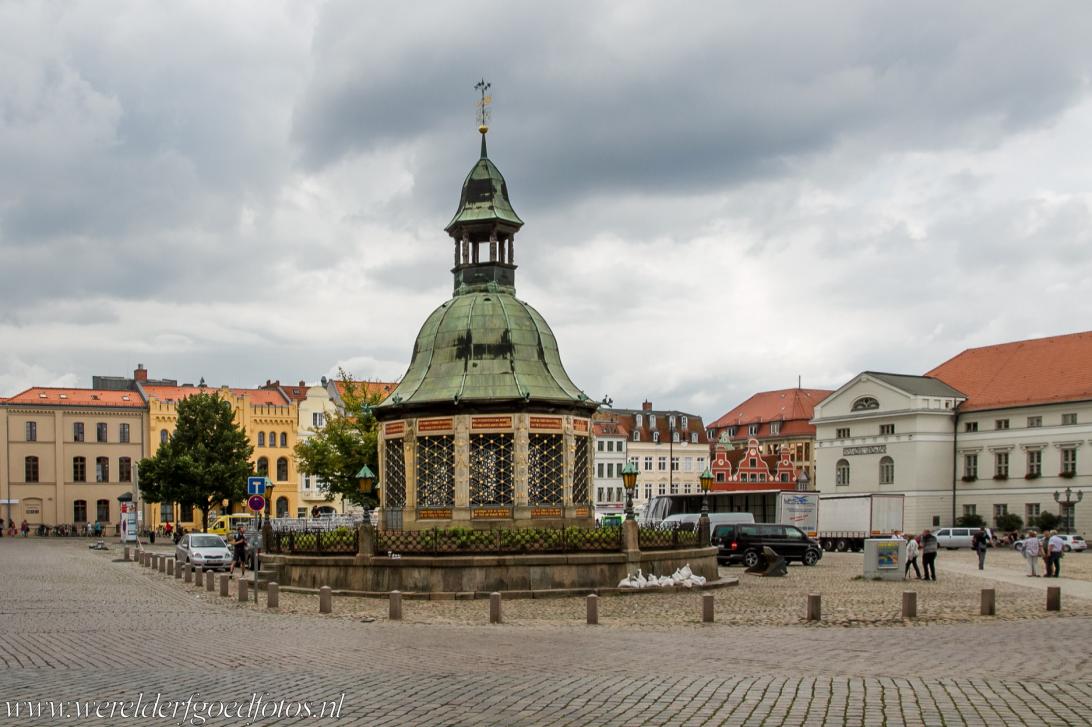
Historic Centre of Wismar: The Wasserkunst (Water Art) is a water fountain built of decorative stonework, limestone and wrought iron. The fountain was built in the Dutch Renassaince style. The Wasserkunst was built after the plans of the Dutch master builder Philipp Brandin in 1602. The fountain is situated on the Market Square and was the central water reservoir of the town until 1897. The unique Wasserkunst is a symbol of the Hanseatic town of Wismar.

Historic Centre of Wismar: The Wasserkunst (Water Art) is a water fountain built of decorative stonework, limestone and wrought iron. The fountain was built in the Dutch Renassaince style. The Wasserkunst was built after the plans of the Dutch master builder Philipp Brandin in 1602. The fountain is situated on the Market Square and was the central water reservoir of the town until 1897. The unique Wasserkunst is a symbol of the Hanseatic town of Wismar.
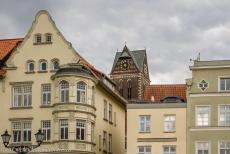
Historic Centre of Wismar: The tower of the St. Marienkirche, the Church of St. Mary, rises high above Wismar. The church was built in the 13th century by wealthy merchants of Wismar. The church was damaged during the Second World War and deliberately destroyed in 1960 during the DDR period, the 80 metres high tower is the only remaining part of the brick Gothic church. Once, the Marienkirche was considered one of the finest brick churches in Northern Germany.
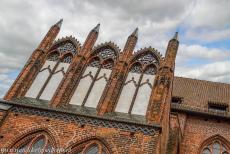
Historic Centre of Wismar: The Church of the Holy Spirit was built in the 13th century soon after the founding of the town. One of the stained glass windows was once part of Wismar's Church of St. Mary (Marienkirche) before its destruction in 1960, this 15th century window is one of the finest examples of medieval Baltic stained glass. The red brick Gothic church also houses several art objects, such as a 1585 Renaissance pulpit, an altar and a 14th century fresco.
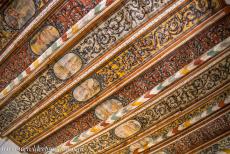
Historic Centre of Wismar: The decorative ceiling of the Church of the Holy Spirit. The flat ceiling was constructed and decorated in the 17th century. The ceiling is embellished with 26 rosettes depicting several stories from the Bible, the solid wooden beams are painted in traditional Baltic forms and colours. The Church of the Holy Spirit served as both a hospital and church. The beds for the ill and the poor were placed in the nave of the church.
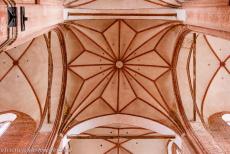
Historic Centre of Wismar: The vaults of the Church of St. George are decorated with red brick. The Church of St. George is one of the three main churches of Wismar. The church was built in the 13th century and is a fine monument of the brick Gothic architecture in Northern Germany. Inside, the height of the vaults is spectacular. The church was damaged during World War II, the restoration started in the 1990s, after the German reunification.
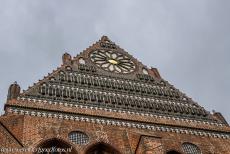
Historic Centre of Wismar: The Nikolaikirche, the Church of St. Nicholas, was built in the period 1381-1487. The brick Gothic Nikolaikirche was erected for sailors and fishermen. The design of the church was based on the Church of St. Mary in Lübeck. The nave of the church is the fourth highest nave in Germany. The church was only slightly damaged during World War II, it houses several works of art from the destroyed Wismar's Church of St. Mary, the St. Marienkirche.
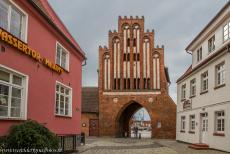
Historic Centre of Wismar: The Wassertor, the Watergate, is the only one left of the five original gate towers in the medieval fortifications of the Hanseatic town of Wismar. The Watergate was the fist line of defence against the invasions of the Danes and Swedes. The Watergate was built in the brick Gothic style around 1450, the gable has been redesigned around 1600. The gate is facing the Old Harbour of Wismar.
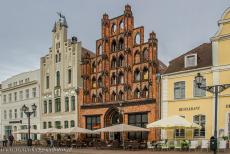
Historic Centre of Wismar: The Alter Schwede is a historic brick patrician house on the Market Square. The Alter Schwede was built in the brick Gothic style around 1380. The town of Wismar was under Swedish rule from 1648 until 1871. The red brick house was called the Alter Schwede in 1878, as a reminder of the Swedish period of Wismar. The Alter Schwede is considered one of the most beautiful Gothic buildings in Germany. Nowadays, it houses a restaurant.
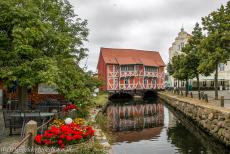
Historic Centre of Wismar: The Gewölbe is a half-timbered building over a small stream, called the Runde Grube. The Runde Grube flows into the Old Harbour of Wismar, which is connected to the Baltic Sea. The Gewölbe was built in the 17th century to serve as a quality control station, where the wine merchants of Wismar brought their port wines for quality control before trading them at the wine cellar beneath the town hall.
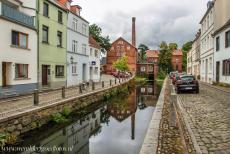
Historic Centre of Wismar: The Old Town Mill on the banks of the Mühlenbach, a section of the Grube, a small artificial stream in Wismar, created in the 13th century to transport goods from the harbour into the town centre. The Grube also provided water to turn the waterwheels and the millstones of the factories. The Grube is divided into three sections, the Frische Grube, the Mühlenbach and the Runde Grube. The historic centre of Wismar is a UNESCO World Heritage.
